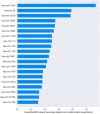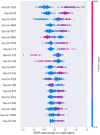Joint global and local interpretation method for CIN status classification in breast cancer
- PMID: 38562500
- PMCID: PMC10982965
- DOI: 10.1016/j.heliyon.2024.e27054
Joint global and local interpretation method for CIN status classification in breast cancer
Abstract
Breast cancer is among the cancer types with the highest numbers of new cases. The study of this disease from a microscopic perspective has been a prominent research topic. Previous studies have shown that microRNAs (miRNAs) are closely linked to chromosomal instability (CIN). Correctly predicting CIN status from miRNAs can help to improve the survival of breast cancer patients. In this study, a joint global and local interpretation method called GL_XGBoost is proposed for predicting CIN status in breast cancer. GL_XGBoost integrates the eXtreme Gradient Boosting (XGBoost) and SHapley Additive exPlanation (SHAP) methods. XGBoost is used to predict CIN status from miRNA data, whereas SHAP is used to select miRNA features that have strong relationships with CIN. Furthermore, SHAP's rich visualization strategies enhance the interpretability of the entire model at the global and local levels. The performance of GL_XGBoost is validated on the TCGA-BRCA dataset, and it is shown to have an accuracy of 78.57% and an area under the curve value of 0.87. Rich visual analysis is used to explain the relationships between miRNAs and CIN status from different perspectives. Our study demonstrates an intuitive way of exploring the relationship between CIN and cancer from a microscopic perspective.
Keywords: Breast cancer; Chromosomal instability; SHAP; XGBoost; miRNAs.
© 2024 The Authors.
Conflict of interest statement
The authors declare that they have no known competing financial interests or personal relationships that could have appeared to influence the work reported in this paper.
Figures










Similar articles
-
A machine learning model based on ultrasound image features to assess the risk of sentinel lymph node metastasis in breast cancer patients: Applications of scikit-learn and SHAP.Front Oncol. 2022 Jul 25;12:944569. doi: 10.3389/fonc.2022.944569. eCollection 2022. Front Oncol. 2022. PMID: 35957890 Free PMC article.
-
Extreme gradient boosting model to assess risk of central cervical lymph node metastasis in patients with papillary thyroid carcinoma: Individual prediction using SHapley Additive exPlanations.Comput Methods Programs Biomed. 2022 Oct;225:107038. doi: 10.1016/j.cmpb.2022.107038. Epub 2022 Jul 23. Comput Methods Programs Biomed. 2022. PMID: 35930861
-
Predicting Mortality in Intensive Care Unit Patients With Heart Failure Using an Interpretable Machine Learning Model: Retrospective Cohort Study.J Med Internet Res. 2022 Aug 9;24(8):e38082. doi: 10.2196/38082. J Med Internet Res. 2022. PMID: 35943767 Free PMC article.
-
Insights into geospatial heterogeneity of landslide susceptibility based on the SHAP-XGBoost model.J Environ Manage. 2023 Apr 15;332:117357. doi: 10.1016/j.jenvman.2023.117357. Epub 2023 Jan 31. J Environ Manage. 2023. PMID: 36731409 Review.
-
Interpretable machine learning model to predict surgical difficulty in laparoscopic resection for rectal cancer.Front Oncol. 2024 Feb 6;14:1337219. doi: 10.3389/fonc.2024.1337219. eCollection 2024. Front Oncol. 2024. PMID: 38380369 Free PMC article. Review.
References
-
- Sung H., Ferlay J., Siegel R.L., Laversanne M., Soerjomataram I., Jemal A., Bray F. Global cancer statistics 2020: globocan estimates of incidence and mortality worldwide for 36 cancers in 185 countries. CA Cancer J. Clin. 2021;71(3):209–249. - PubMed
LinkOut - more resources
Full Text Sources

